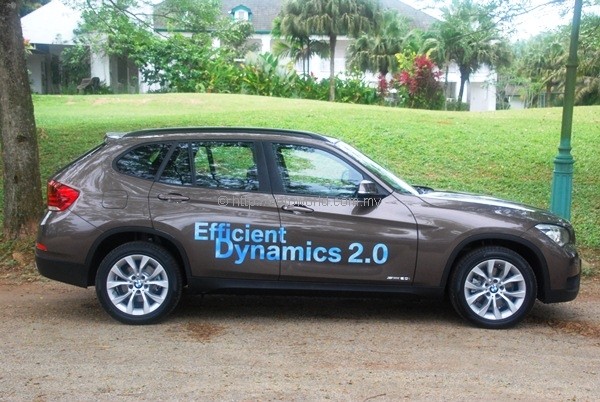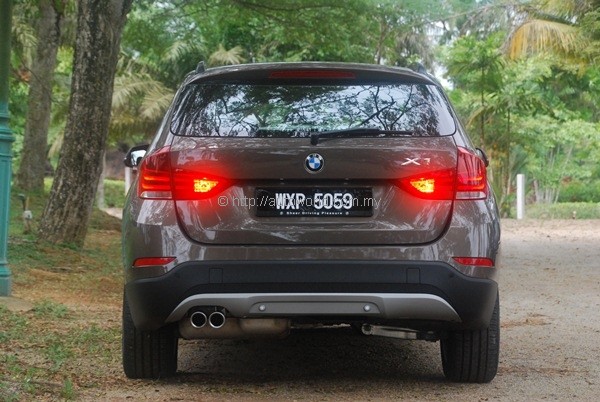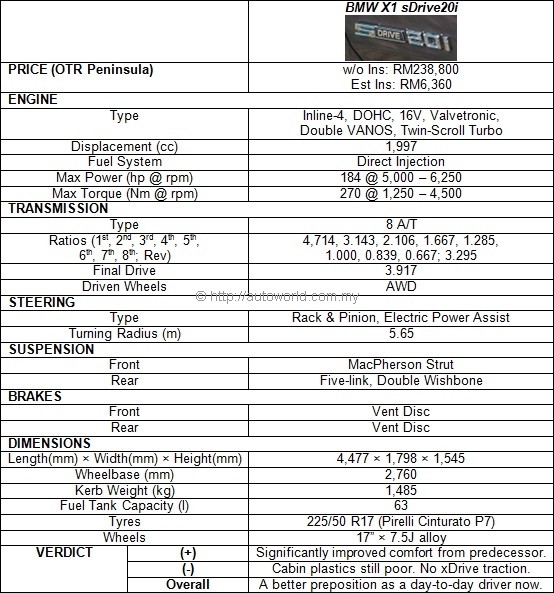BMW X1 sDrive20i Test Drive Review
Earlier this month, we took a drive to the beaches of Desaru at the east coast of Johor and back in a fleet of spanking new BMW vehicles all powered by the same 2.0-litre N20 TwinPower Turbo engine in BMW’s EfficientDynamics 2.0 media drive. Having published our review of the 320i, we now follow up on the newly-introduced X1 sDrive20i that also came along for the trip.
The X1 was first launched here in 2010 with a choice of petrol and diesel powertrains, both four-cylinder mills displacing two litres. The facelifted version was announced in November, with a new petrol-powered rear-wheel driven sDrive20i replacing the previous sDrive18i. The diesel model has been removed from the catalogue; this is likely to be a temporary omission, but at the moment, there is no diesel or all-wheel drive option for the X1.
 |
| It takes a sharp eye to spot the X1’s facelift changes. |
Pleasingly for customers, except may be those who just bought the predecessor, the sDrive20i with a more powerful engine and new 8-speed automatic transmission is available at exactly the same price as the outgoing sDrive18i at RM238,800. In essence, we are talking about an upgrade of 28hp, 70Nm, and two forward ratios for free. That’s fantastic value by any standards.
Our first encounter with the pre-facelift X1 was in its diesel-powered all-paw xDrive20d guise. That car was a bit of a mixed bag – its dynamics and road holding were mind-bendingly good as we coaxed it to corner at speeds that simply beggared belief. BMW’s brilliant xDrive system endowed the X1 with almost supernatural levels of grip, but the whole package was let down in other areas that made the X1 a difficult choice to recommend. Its superstiff suspension was unbearable in all but the smoothest of roads, and interior plastics used were of shocking quality. Then there is the way it looks which we simply will not get into.
 |
| X1’s front fascia certainly hasn’t grown on us with time. |
The new X1’s ride quality has seen definite improvement. Barely a few kilometres behind the wheel were needed before the impressive differences were noticed. While it can be argued that the new X1 does not corner as flatly as its predecessor, it is a compromise that is most definitely worth living with. The new suspension setup is notably more pliant, resulting in better composure over poor road surfaces. In any case, the X1 still outhandles the competition, so enthusiasts need not lament.
Another key mechanical change made to the new X1 is the introduction of electric power steering to substitute its predecessor’s hydraulic system. The new rack is notably lighter than before, but with less feedback. Personally, I prefer the older car’s heavier rack, but the current setup is decent for an electric system, and the likelihood is that most customers will appreciate the need for less effort when maneuvering the car. My own car has a pretty heavy steering (for a power-assisted unit), and the pre-facelift X1 was one test car that I distinctly remembered having a heavier steering than my own.
 |
| The absence of iDrive is compensated by extra centre console storage areas. |
Compared to our xDrive20d test unit from two years ago, the new sDrive20i model is a significantly more pleasant day-to-day prospect, despite lacking the diesel engine’s grunt and all-conquering xDrive grip. The reduced communicativeness of its steering also did little to adversely affect the newer model’s overall appeal, although we would ideally like to see the xDrive20d variant’s return but using the current sDrive20i’s softer suspension setup. The sDrive20i’s smaller wheel/tyre combo (17″ vs 18″) is also likely to have contributed to this vastly improved levels of comfort.
Whilst the X1’s ride has now been sufficiently improved to genuinely deserve plaudits, the same cannot be said of its interior. Although overall fit and finish is actually decent, plastics used even in prominent areas of the dash are not only hard, but feel hollow when knocked. It is not the kind of quality we expect from a BMW, and when you couple that with an equipment list that omits even the most basic iDrive system, you have to wonder how this model can be priced on-par with the all-new 320i. Remember, that the X1 is based on the previous-generation 3 Series, and the variant we are testing here does not even have xDrive as an excuse for a bloated price tag. It’s saving grace is that it undercuts the Audi Q3 and, amusingly, the MINI Cooper Countryman.
 |
| Rear appearance is hardly altered. |
Despite looking almost indistinguishable from the older model, the new X1 has matured into a better-rounded package thanks to the excellent new engine and more sensible dynamics. The significant gains in comfort are worth praising, but its interior could certainly be better. For RM238,800, the 320i, which comes with exactly the same engine but sitting on a platform that is one generation newer, is actually the more worthwhile purchase from within the BMW line-up.
As a compact SUV, however, the X1’s dynamics remain unsurpassed. The Audi Q3 and Volkswagen Tiguan do give you better cabins for the money, the X1 is the best to drive among this three by a far margin and is now comparable in terms of comfort. If you are seeking a compact SUV with good driving dynamics as a key criteria, then yes, by all means, go for the BMW X1, but truth be told, rivals do offer better rounded packages.
 |
























